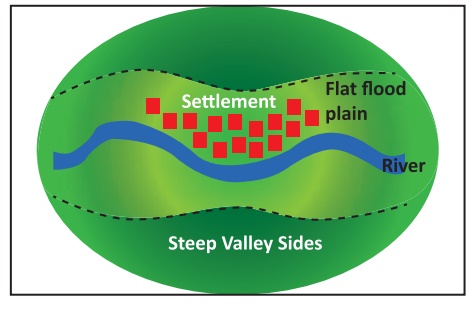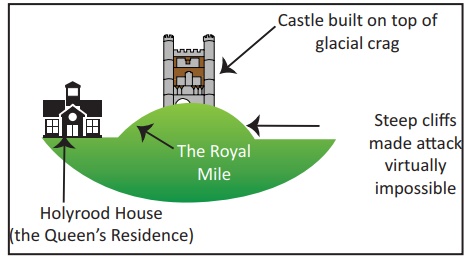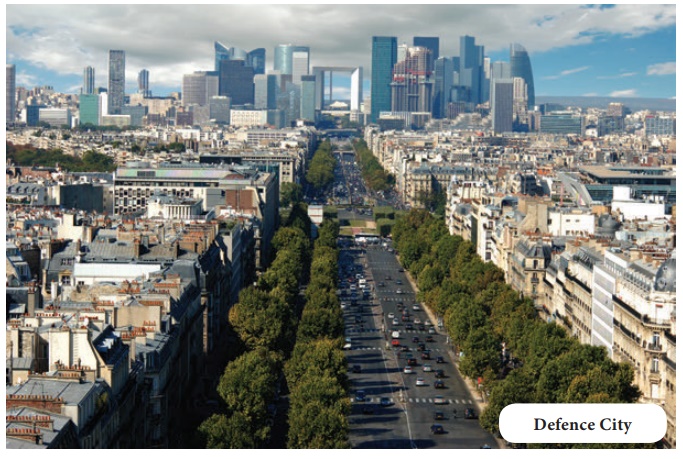Geography - Site and Situation | 12th EM Geography : Chapter 2 : Human Settlements
Chapter: 12th EM Geography : Chapter 2 : Human Settlements
Site and Situation
Site and Situation
Site
The
Site of a settlement describes the physical nature of where it is located.
Factors such as water supply, building materials, quality of soil, climate,
shelter and defence were all considered when settlements were first
established. For instance, the site of Sydne y, in Australia, initially took
advantage of the excellent natural harbour and surrounding fertile farmland.

Aspect and shelter are
two of the most important factors
that were considered when deciding where to locate a settlement. Aspect relates
to the direction in which the land faces. In the Northern Hemisphere the best
slopes to locate on are those that face south, as they will receive the most
sunshine, and therefore be the best for agriculture. This can be seen clearly
in many of the valleys of the Alps, where settlements have located on the
south-facing slopes.
Shelter
is also very important, particularly from the cold northerly winds and
prevailing south westerly winds in the UK. A good example of settlements being
sheltered by their natural surroundings are the many spring-line settlements
found along the base of the chalk escarpments of the North and South Downs.
These settlements would also have benefited from the good water source and
fertile farmland nearby.
1. Water supply
Water
supply is probably the single most important factor in deciding where a
settlement might be located. Not only do rivers provide a source of clean
drinking water, they also provide a food source through fishing, and a
transport route. Most of the world's largest cities are located on rivers,
especially the point at which they reach the sea, as this was often the first
point that explorers landed.
2. Dry point sites
A
dry point site is one that is slightly raised from the surrounding area,
meaning that it is less likely to flood. Ely in Cambridgeshire, England, is a
good example of dry point site.

3. Wet point sites
Wet
point site refers to any site that has access to water, usually through being
beside a river. Towns would either grow up along the river or clustered near
the point at which the river enters the sea. Examples of wet point sites
include the towns and villages of the Welsh valleys, which tend to extend along
the flat valley floor, rather than up the steep valley sides. Spring line
settlements in the North and South Downs, England are also good examples of wet
point sites.

4. Defence
In
medieval times, defence was one of the most important factors influencing the
site of a settlement. The relief of the land often proved to be the best form
of defence. Edinburgh castle sits on the top of a glacial crag, in an almost
perfect position to defend itself, with very little chance for the attackers.
In Italy, there are many walled hill-top villages, whilst the Maoris in New
Zealand built their settlements (called Pa's) on the top of steep hills to
prevent being attacked. In India, Ichhapur Defence Estate is a census town in
Barrackpore, West Bengal.
The
other common natural feature used for defence is water, and in particular
rivers. Both Shrewsbury and Durham are very good examples of where a meander of
the river has formed an area of land bounded by water on three sides. This
provided both cities with excellent defence, as they only had a thin neck of
land to defend.


5. Resources
The
idea of resources covers a huge number of different things. For early settlers
the most important resources were fuel, building materials and food.
Settlements grew in areas where wood was plentiful, stone easily accessible and
good soil allowed agriculture to be developed.
Since
in early days of settlement many different resources have become the focal
points for the growth of urban areas.
6. Mining
The
coal mines of South Wales, Tin mines of Cornwall and large mining projects at
Carajas in Northern Brazil, have all encouraged the rapid growth of settlements
aimed at housing the workers and providing them with all that they require.
7. Precious metals
Settlements
in South Africa have grown after the discovery of large deposits of precious
metals such as gold. The most famous settlement grew due to finding gold is San
Francisco, after the gold rush to California in 1849.
8. Route centres
Route
centres are often called Nodal Points. Nodal Points are formed by the meeting
of two valleys, but settlement nowadays will grow where two main roads meet. In
the UK, York is a good example of a route centre. Birmingham also enjoys a very
good location, where many routes join up, and this is one of the reasons for
its growth to become one of the largest cities in the UK.


9. Bridging points
Just
as water is very important for drinking, fishing, irrigation and navigation, so
the ability to cross the rivers is also very important.
Many
towns and cities have built up at points where it was the easiest to cross a
large river. Exeter is one such example, crossing the river Exe in England.
However
one of the best examples is Paris in France. The original town was based on the
tiny Ile dela Cite, which is an island in the middle of the River Seine. This
island meant they could build two small bridges across the river rather than
one large one.

Nowadays
the island has been engulfed by the huge city that Paris has become, however it
does still have many bridges going to it and is the point where the huge Notre
Dame Cathedral is built.
10. The confluence of two rivers
Just
as two valleys, or roads, make a nodal point for settlement growth, so do two
rivers joining. One such example is found in Khartoum in Sudan, where the Blue
and the White Nile meet. In India, Allahabad is located at the confluence of
River Ganga and Yamuna and Bhavani (Tamil Nadu) is at the confluence of River
Cauvery and Bhavani.


Situation
The
situation of a settlement is the description of the settlement in relation to
the other settlements and physical features around it. The situation of a
settlement is the most important in determining whether it grows to become a
large city or stays as a small town or village.
In
the UK, Birmingham is an example of a city with excellent situation. It is
located central to the country, with excellent links by road to the North and
South to London.
As
cities begin to fulfill different functions their importance can increase or
decrease. Their situation plays an important part in deciding which of these
functions will occur.
It
refers to the location of the actual settlement. The initial choice of a site
for a settlement depends on its meeting certain daily needs such as water
supply, availability of potential farmland, building materials and fuels etc.
Settlements
can broadly be divided into two types – rural and urban. Let us know some
differences between rural and urban areas in general.
i.
The major difference between rural
and urban areas is the function. Rural areas have predominantly primary
activities such as agriculture, whereas urban areas have domination of
secondary and tertiary activities such as manufacturing industries and service
sectors.
ii.
Generally the rural areas have low
density of population than urban areas.
iii.
Urban settlements are defined by
their advanced civic amenities, opportunities for education, and facilities for
transport, business and social interaction and overall better standard of
living whereas rural areas lack of such amenities.
iv.
Rural areas do not have pollution or
traffic problems that beset regular urban areas.
v.
In the rural society there was very
little scope for occupational mobility. In cities there are many occupations,
so occupational mobility is frequent.
vi.
Rural people are less mobile and
therefore the social relations among them are intimate. In urban areas, the way
of life is complex and fast, hence, the social relations are formal.
Related Topics